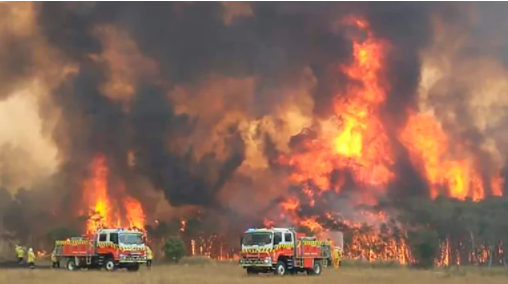Australia’s Bush Fires: Millions of Tonnes of Carbon Emitted, Phytoplankton Bloom Observed

Image Courtesy: Twitter@NSWRFS via AP
The ravaging bush-fires that caused devastation across south-eastern Australia in late 2019 and early 2020 is still alive in memory. However, what was the scale of the damage to the environment caused by the fumes emanating from the wild fires?
A study published in the science journal Nature on September 15 has come out with a concerning estimate of a staggering amount of carbon released into the environment in the fires. According to the study, the carbon dioxide released was over 715 million tonnes, more than double the previous estimates which were calculated based on satellite data.
The unprecedented fires linked to climate change burned around 74,000 square kilometers of land in south-east Australia with the blaze ravaging primarily eucalyptus or gum forests. Previous estimates said that at the peak of the fire – November 2019 to January 2020 – about 275 million tonnes of carbon dioxide was released. These estimates came about from data of global databases of wildfire emissions, which are based on satellite observations.
The new analysis has shown that the previous satellite-based estimates were gross underestimates. “These models often lack the spatio-temporal detail to explain the full impact these fires have,” Ivar van der Velde, the lead author of the study, reportedly said. Van der Velde is an environmental scientist at the SRON Netherlands Institute for Space Research, in Utrecht, and at the Free University of Amsterdam.
In order to get a better estimate, the team of researchers used European Space Agency’s (ESA) instruments. They used TROPOMI, which is a tropospheric monitoring instrument of ESA’s Sentinel 5 precursor satellite.
TROPOMI records daily snapshots of carbon monoxide levels. The researchers used this data to arrive at a more accurate level of carbon monoxide emissions from the bushfires. They used this data as a proxy for the calculation of emission levels.
Commenting on the staggering amount of carbon dioxide released from the fires, David Bowman, an ecologist at the University of Tasmania reportedly said that it was “a stupendous amount”. “Scientists might have to rethink the impact on global climate of extreme blazes, which have now raged not just across Australia, but across the western United States and Siberia. Fire is a really big deal now,” he added.
A second paper, also published in Nature the same day, hinted that there might be good news too. The research suggests that gigantic blooms of phytoplankton were observed in the Southern Ocean and that it could have taken in the emissions. The phytoplankton is a marine alga. The findings also demonstrated that wild fires can have a direct influence over ocean processes.
The researchers found that the black fumes were swept thousands of kilometres over the ocean during the fires. The fumes consisted of nutrients for the phytoplankton, which, infused iron in the water within a few days. This is a much-needed nutrient for the phytoplankton. When it bloomed, the phytoplankton sucked carbon equivalent to about 95% of the emissions.
However, there is a caveat, as raised by Bowman and others. “More work needs to be done to understand where the carbon taken up by the plankton eventually goes, and whether it makes it back out into the atmosphere,” he was quoted saying.
Both the studies try to get a better understanding of fires, which are increasingly becoming an important factor in the carbon cycle. As climate changes and there is an increase in wild fires across the world, it will be important to know how they impact the carbon cycle (the ecological process in which carbon atoms travel from the atmosphere to Earth and then get back to the atmosphere).
Get the latest reports & analysis with people's perspective on Protests, movements & deep analytical videos, discussions of the current affairs in your Telegram app. Subscribe to NewsClick's Telegram channel & get Real-Time updates on stories, as they get published on our website.























